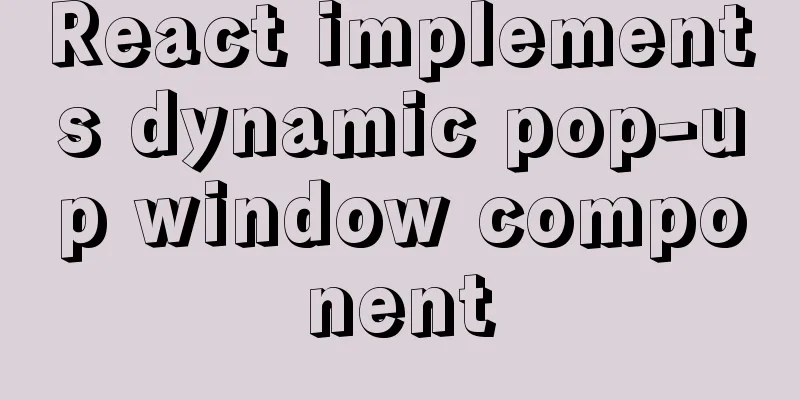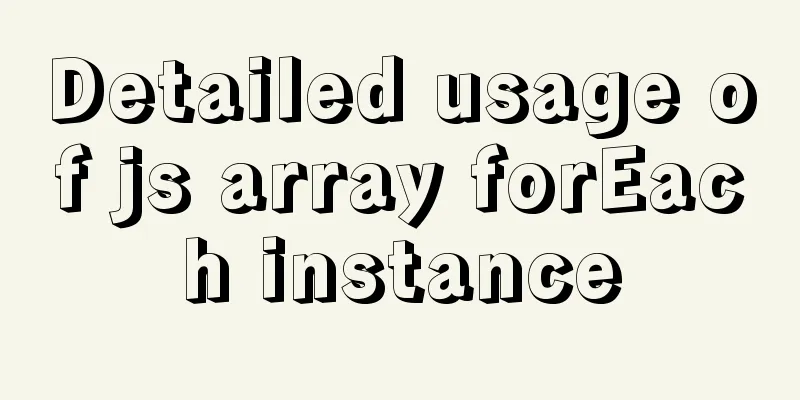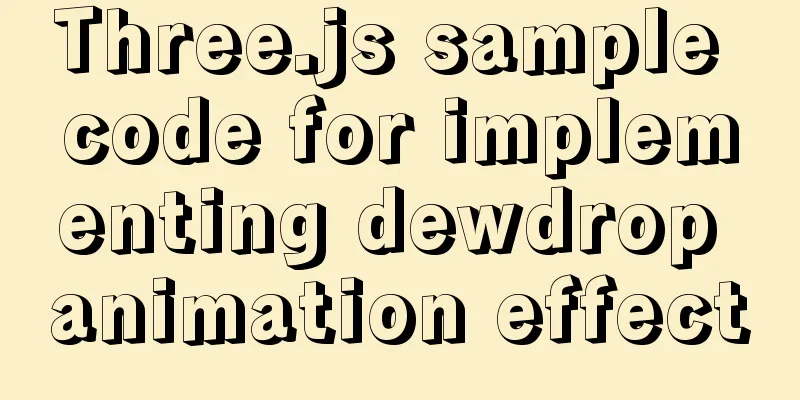React implements dynamic pop-up window component

|
When we write some UI components, if we don't consider the animation, it is very easy to achieve. The main thing is to switch the presence or absence (similar to the v-if attribute in Vue) or the visibility (similar to the v-show attribute in Vue).
1. Pop-ups without animationIn React, this can be achieved like this: interface ModalProps {
open: boolean;
onClose?: () => void;
children?: any;
}
const Modal = ({open.onClose, children}: ModalProps) => {
if (!open) {
return null;
}
return createPortal(<div>
<div classname="modal-content">{children}</div>
<div classname="modal-close-btn" onclick="{onClose}">x</div>
</div>, document.body);
};Directions: const App = () => {
const [open, setOpen] = useState(false);
return (
<div classname="app">
<button onclick="{()" ==""> setOpen(true)}>show modal</button>
<modal open="{open}" onclose="{()" ==""> setOpen(false)}>
Modal content
</modal>
</div>
);
}; Here we use the If we want to achieve animation effects such as fade and zoom, we need to modify this.
2. Create animated pop-ups yourselfWhen many students implement animation effects themselves, they often find that the animation works when it is displayed, but not when it is closed. It’s all because the timing of the animation was not controlled well. Here we first implement the flow of dynamic effects ourselves. When I first started implementing it, the animation only had a start state and an end state, and it required a lot of variables and logic to control the animation. Later, I referred to the implementation of
The animation process is in the process of We use a variable active to control whether the closing animation has been executed, and the parameter open only controls whether the expansion animation or the closing animation is executed. The popup window is destroyed only when both open and active are false. const Modal = ({ open, children, onClose }) => {
const [active, setActive] = useState(false); // Pop-up window existence cycle if (!open && !active) {
return null;
}
return ReactDOM.createPortal(
<div classname="modal">
<div classname="modal-content">{children}</div>
<div classname="modal-close-btn" onclick="{onClose}">
x
</div>
</div>,
document.body,
);
};Here we continue to add changes in the animation process: const [aniClassName, setAniClassName] = useState(''); // Animation class
// Transition execution completed listening function const onTransitionEnd = () => {
// When open is rue, the end state is 'enter-done'
// When open is not false, the end status is 'exit-done'
setAniClassName(open ? 'enter-done' : 'exit-done');
// If open is false, the pop-up window's life cycle ends when the animation ends if (!open) {
setActive(false);
}
};
useEffect(() => {
if (open) {
setActive(true);
setAniClassName('enter');
// setTimeout is used to switch classes and make transition happen setTimeout(() => {
setAniClassName('enter-active');
});
} else {
setAniClassName('exit');
setTimeout(() => {
setAniClassName('exit-active');
});
}
}, [open]);The complete code of the Modal component is as follows: const Modal = ({ open, children, onClose }) => {
const [active, setActive] = useState(false); // Pop-up window existence cycle const [aniClassName, setAniClassName] = useState(''); // Animation class
const onTransitionEnd = () => {
setAniClassName(open ? 'enter-done' : 'exit-done');
if (!open) {
setActive(false);
}
};
useEffect(() => {
if (open) {
setActive(true);
setAniClassName('enter');
setTimeout(() => {
setAniClassName('enter-active');
});
} else {
setAniClassName('exit');
setTimeout(() => {
setAniClassName('exit-active');
});
}
}, [open]);
if (!open && !active) {
return null;
}
return ReactDOM.createPortal(
<div classname="{'modal" '="" +="" aniclassname}="" ontransitionend="{onTransitionEnd}">
<div classname="modal-content">{children}</div>
<div classname="modal-close-btn" onclick="{onClose}">
x
</div>
</div>,
document.body,
);
};The flow process of the animation has been realized, and the style should also be written together. For example, we want to achieve a fade effect: .enter {
opacity: 0;
}
.enter-active {
transition: opacity 200ms ease-in-out;
opacity: 1;
}
.enter-done {
opacity: 1;
}
.exit {
opacity: 1;
}
.exit-active {
opacity: 0;
transition: opacity 200ms ease-in-out;
}
.exit-done {
opacity: 0;
}If you want to achieve the zoom effect, just modify these classes. A pop-up window with animation has been implemented. Directions: const App = () => {
const [open, setOpen] = useState(false);
return (
<div classname="app">
<button onclick="{()" ==""> setOpen(true)}>show modal</button>
<modal open="{open}" onclose="{()" ==""> setOpen(false)}>
Modal content
</modal>
</div>
);
};Click the link to implement your own React pop-up window demo to see the effect. Similarly, there are Toast and the like, which can also be implemented in this way.
3. react-transition-group We borrowed the CSSTransition component in react-transition-group to achieve the dynamic effect. There is an important property here: const Modal = ({ open, onClose }) => {
// http://reactcommunity.org/react-transition-group/css-transition/
// in property is true/false, true is to expand the animation, false is to close the animation return createPortal(
<csstransition in="{open}" timeout="{200}" unmountonexit="">
<div classname="modal">
<div classname="modal-content">{children}</div>
<div classname="modal-close-btn" onclick="{onClose}">
x
</div>
</div>
</csstransition>,
document.body,
);
};After using the CSSTransition component, Modal's animation becomes much more convenient.
4. Conclusion So far, the React Modal component to be animated has been implemented. Although there is no The above is the details of how to implement dynamic pop-up window components in React. For more information about React pop-up window components, please pay attention to other related articles on 123WORDPRESS.COM! You may also be interested in:
|
>>: Explanation of the configuration and use of MySQL storage engine InnoDB
Recommend
Introduction to keyword design methods in web design
Many times, we ignore the setting of the web page ...
Some methods to optimize query speed when MySQL processes massive data
In the actual projects I participated in, I found...
Mac+IDEA+Tomcat configuration steps
Table of contents 1. Download 2. Installation and...
Website Building Tutorial for Beginners: Learn to Build a Website in Ten Days
The 10-day tutorial uses the most understandable ...
JavaScript Basics: Immediate Execution Function
Table of contents Immediately execute function fo...
Some slightly more complex usage example codes in mysql
Preface I believe that the syntax of MySQL is not...
Detailed explanation of using Docker to build externally accessible MySQL
Install MySQL 8.0 docker run -p 63306:3306 -e MYS...
JavaScript Regular Expressions Explained
Table of contents 1. Regular expression creation ...
Steps to export the fields and related attributes of MySQL tables
Need to export the fields and properties of the t...
Detailed explanation of solving the problem of cross-domain access of nginx/apache static resources
1. Apache static resource cross-domain access Fin...
CSS to achieve horizontal lines on both sides of the middle text
1. The vertical-align property achieves the follo...
How to clear default styles and set common styles in CSS
CSS Clear Default Styles The usual clear default ...
A solution to the abnormal exit of Tomcat caused by semaphore
I'm playing with big data recently. A friend ...
Detailed explanation of MySQL transaction processing usage and example code
MySQL transaction support is not bound to the MyS...
Analysis of MySQL latency issues and data flushing strategy process
Table of contents 1. MySQL replication process 2....













